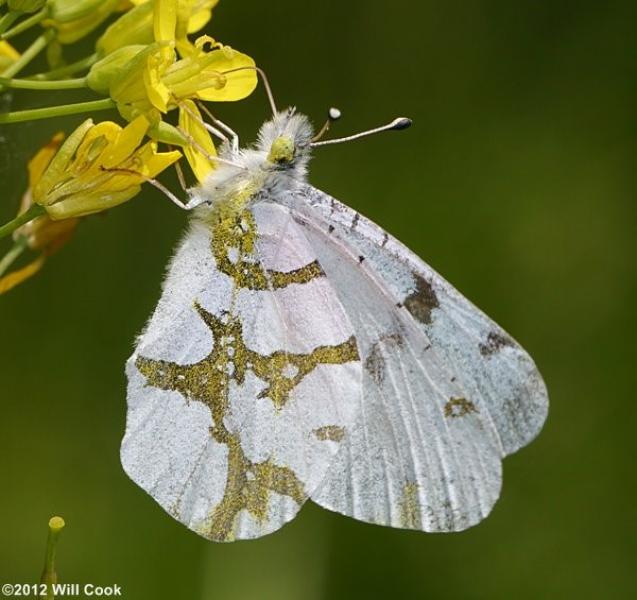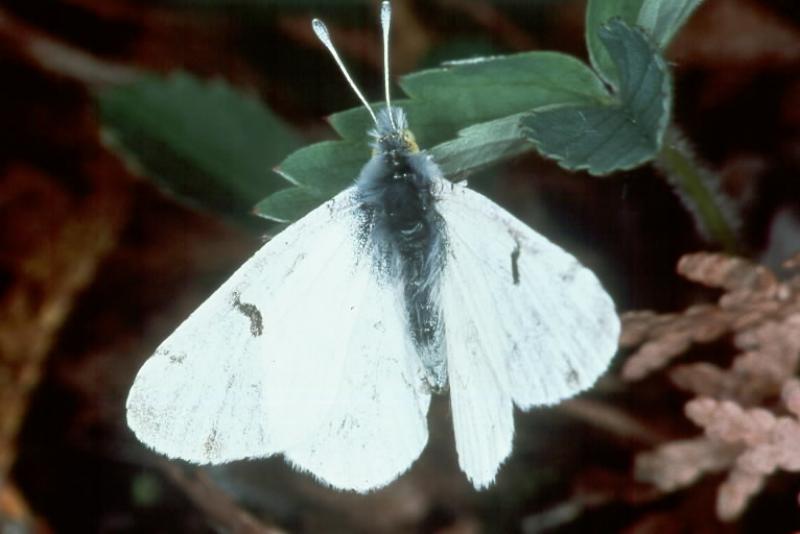Olympia Marble
Euchloe olympia (W.H. Edwards, 1871)
- Class
- Insecta (Insects)
- Family
- Pieridae (Whites and Sulphurs)
- State Protection
- Special Concern
Listed as Special Concern by New York State: at risk of becoming Threatened; not listed as Endangered or Threatened, but concern exists for its continued welfare in New York; NYS DEC may promulgate regulations as to the taking, importation, transportation, or possession as it deems necessary.
- Federal Protection
- Not Listed
- State Conservation Status Rank
- S1
Critically Imperiled in New York - Especially vulnerable to disappearing from New York due to extreme rarity or other factors; typically 5 or fewer populations or locations in New York, very few individuals, very restricted range, very few remaining acres (or miles of stream), and/or very steep declines.
- Global Conservation Status Rank
- G5
Secure globally - Common in the world; widespread and abundant (but may be rare in some parts of its range).
Summary
Did you know?
Alvar pavement grasslands, the community type the Olympia marble inhabits in New York, is limited to only one county in the state (Jefferson County).
State Ranking Justification
This specialist butterfly is confined to a small fraction of the state where its particular Alvar grassland habitat is found.
Short-term Trends
The short-term trend for the species in New York State seems to be stable. It has been reported from two protected sites in Jefferson County. One had sightings until 2005 with no surveys since 2006, and surveys at the other site have recorded an extant population through 2016.
Long-term Trends
The long-term trends are unknown. This species was first discovered in New York in 1986, and surveys from 1986 to 2016 indicate the species was extant during that time. No surveys have been completed at one of the two known sites since 2006.
Conservation and Management
Threats
One of the main threats to the Olympia marble is pesticide use to control spongy moths. Most Lepidoptera are negatively impacted by the chemicals used in spongy moth sprays, and the use of these chemicals could cause a decline in Olympia Marble populations in New York (Butler et al. 1995, Parshall 2002). Populations can also be threatened by prescribed fire and herbicides to maintain habitat openings. Hot prescribed burns can be lethal to individuals, and herbicides can destroy host plants needed by larvae. Habitat destruction is a potential threat in areas that are not already protected. Additionally, the habitat needed for this species is threatened by invasive plant species.
Conservation Strategies and Management Practices
This species is sensitive to chemical spraying (e.g. herbicides, insecticides), and so broadcast use of chemicals in their habitat should be avoided. Managers should also avoid hot burns within inhabited areas, since populations can be impacted by prescribed fire (Butler et al. 1995, Parshall 2002). If an area occupied by the moth must be burned, some areas should be left unburned as refugia for the moth. Sites should be managed to promote growth of larval host plants (Arabis sp.).
Research Needs
One of the most important research needs for this species is more current and complete data regarding species status and distribution. Olympia marble populations would benefit from statewide survey and monitoring efforts in suitable habitat. Other research needs include the amount of area populations need for survival, as well as the density of food plants and nectar sources at known sites (Parshall 2002). Additional information regarding suitable management practices, such as invasive species removal and prescribed fire, is also needed
Habitat
Habitat
This species is generally found in habitats with well-drained soils that appear semi-arid (Opler and Krizek 1984). In New York, the butterflies inhabit a limestone pavement barrens and alvar grassland mosaic (New York Natural Heritage Program 2017). Olympia marbles require habitats with the host plants necessary to complete their life cycle. Olympia marble larvae feed on plants in the rockcress family (Brassicaceae), particularly Arabis X divaricarpa in New York (Parshall 2002, New York Natural Heritage Program 2017).
Associated Ecological Communities
- Dry alvar grassland
(guide)
A grassland community that occurs on very shallow, organic soils that cover limestone or dolostone bedrock.
- Wet alvar grassland
(guide)
A grassland community that occurs on very shallow, organic soils that cover limestone or dolostone bedrock. Average soil depths in this grassland community are less than 10 cm. This community has a characteristic soil moisture regime of alternating wet and dry seasons; many of them have flooded or saturated soils in early spring and late fall, combined with summer drought in most years.
Range
New York State Distribution
Populations of Olympia marble have been documented at two sites in Jefferson County.
Global Distribution
Olympia marbles are widespread and can be found throughout western North America between the Rockies and the Mississippi, and extend from the Great Lakes region in southern Canada and south into Texas. The species also occurs in disjunct populations in the Appalachians from extreme southern Pennsylvania south to Kentucky, with populations in western Maryland, Virginia, and northeastern West Virginia. Small populations also exist in New York and North Carolina (NatureServe 2017).
Best Places to See
- Chaumont Barrens Preserve (Jefferson County)
Identification Comments
General Description
Olympia marble adults are mostly white with open, simplified yellow-green marbling on the underside of the hindwing, and a black bar in the forewing. The caterpillar is mostly gray-green, with yellow subdorsal stripes.
Identifying Characteristics
Olympia marble adults are mostly white with open, simplified yellow-green marbling on the underside of the hindwing, and a black bar in the forewing cell (Opler and Malikul 1992). Males have a forewing width of 1.5-2.1 cm, and females have a forewing width of 1.6-2.3 cm (Opler and Krizek 1984). Living Olympia marbles have a ventral hindwing with a pink-tinged band along the costal margin (Opler and Krizek 1984). The caterpillar is mostly gray-green, with yellow subdorsal stripes (Opler and Malikul 1992). Caterpillars also have sublateral white stripes bordered by yellow beneath them.
Characters Most Useful for Identification
The marbling on the underside of the hindwing is usually the most visible and easily identifiable characteristic for this species.
Best Life Stage for Proper Identification
Adult.
Behavior
Flight is steady, direct and close to the ground. Males tend to fly along ridges and hilltops (Opler and Krizek 1984, Opler and Malikul 1992).
Diet
Foodplants include rock cresses, chickweed, houstonia, and phlox. Caterpillar host plants are rock cresses - frequently Arabis X divaricarpa in New York (Stanton 1997, Parshall 2002).
Best Time to See
Olympia Marbles have one brood per year, and they overwinter as pupa (Holmes et al. 1991, Parshall 2002). Adults emerge in May and are active through June. The female lays single eggs on flower buds and leaves of the host plant in May or June, where the eggs remain until hatching approximately seven days later. Larvae feed on the host plant’s flower buds, flowers, seedpods, and sometimes leaves, until forming a chrysalis, usually occurring in June.
- Reproducing
- Larvae present and active
- Eggs present outside adult
- Pupae or prepupae present
The time of year you would expect to find Olympia Marble reproducing, larvae present and active, eggs present outside adult, and pupae or prepupae present in New York.
Similar Species
- Falcate Orangetip (Anthocharis midea)
The Olympia marble is similar in appearance to the Falcate Orangetip, also found in New York (Opler and Malikul 1992). These two species can be distinguished by the Falcate Orangetip's highly fractured green pattern on the underside of the hindwing, and the orange tip of the forewing's upperside in males
Olympia Marble Images
Taxonomy
Olympia Marble
Euchloe olympia (W.H. Edwards, 1871)
- Kingdom Animalia
- Phylum Arthropoda
(Mandibulates)
- Class Insecta
(Insects)
- Order Lepidoptera
(Butterflies, Skippers, and Moths)
- Family Pieridae (Whites and Sulphurs)
- Order Lepidoptera
(Butterflies, Skippers, and Moths)
- Class Insecta
(Insects)
- Phylum Arthropoda
(Mandibulates)
Additional Resources
References
Butler, L., C. Zivkovich, and B.E. Sample. 1995. Richness and Abundance of Arthropods in the oak canopy of West Virginia's Eastern Ridge and Valley section during a study of impact of Bacillus thuringiensis with emphasis on macrolepidoptera larvae. West Virginia University, Agricultural and Forestry Experimental Station Bulletin. 711. 19p.
Holmes, A.M., Q.F. Hess, R.R. Tasker, and A.J. Hanks. 1991. The Ontario Butterfly Atlas. Toronto Entomologists' Association, Toronto, ON. 167 pp.
NatureServe. 2017. NatureServe Explorer: An online encyclopedia of life [web application]. Version 7.1. NatureServe, Arlington, Virginia. Available http://www.natureserve.org/explorer. (Accessed: June 15, 2017)
New York Natural Heritage Program. 2017. Element Occurrence Database. State University of New York College of Environmental Science and Forestry, Albany, NY.
New York Natural Heritage Program. 2024. New York Natural Heritage Program Databases. Albany, NY.
Opler, P.A. and G.O. Krizek. 1984. Butterflies East of the Great Plains, an illustrated natural history. Johns Hopkins University Press. Baltimore. 294pp.
Opler, P.A. and V. Malikul. 1992. A field guide to eastern butterflies. Houghton Mifflin, Boston, MA. 396 pp.
Parshall, D.K. 2002. Conservation assessment for Olympia marble butterfly (Euchloe olympia). USDA Forest Service, Eastern Region.
Stanton, E.J. 1997. Inventory of the macrolepidoptera on alvars of Jefferson County, New York.
Links
About This Guide
This guide was authored by: Ashley Ballou
Information for this guide was last updated on: April 18, 2019
Please cite this page as:
New York Natural Heritage Program. 2024.
Online Conservation Guide for
Euchloe olympia.
Available from: https://guides.nynhp.org/olympia-marble/.
Accessed April 24, 2024.

